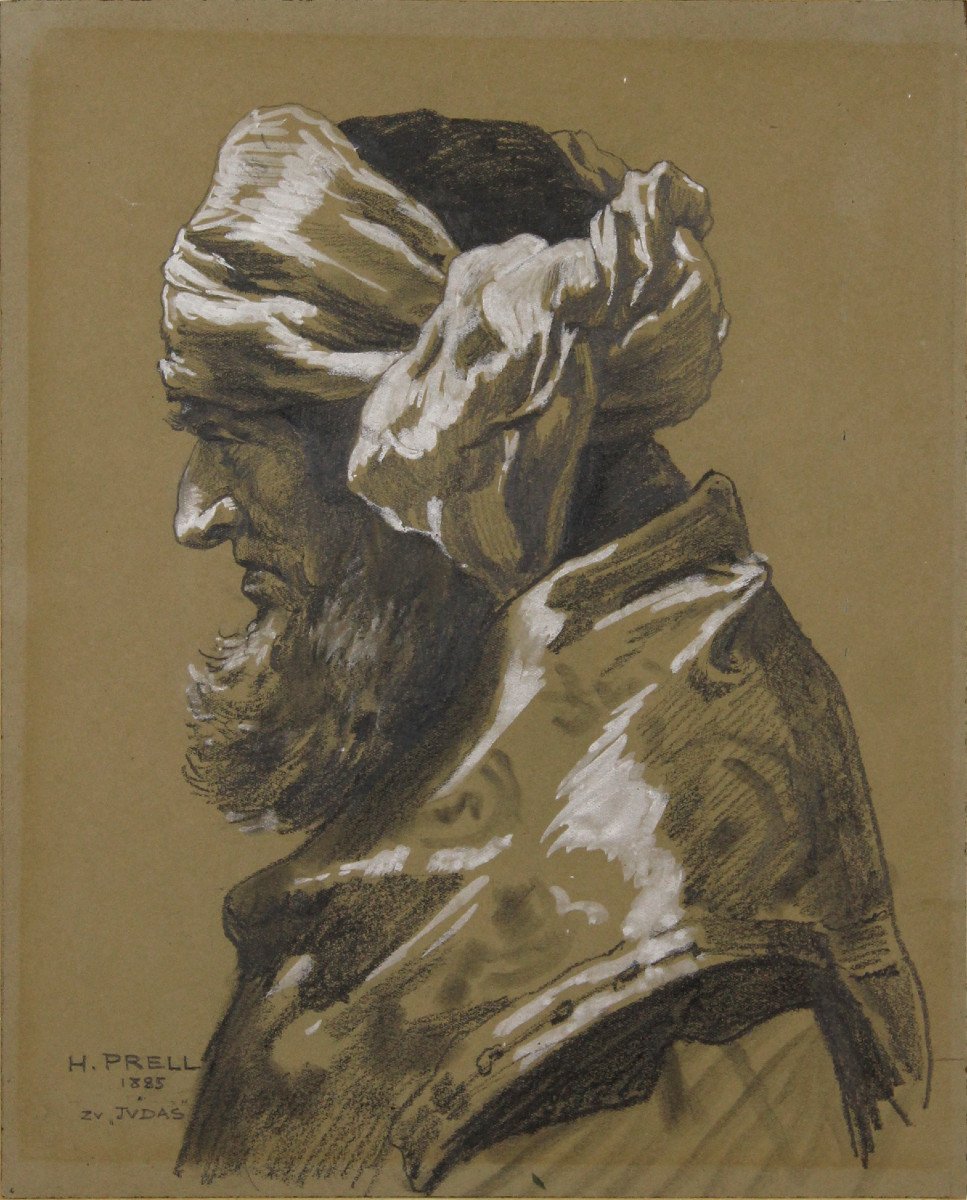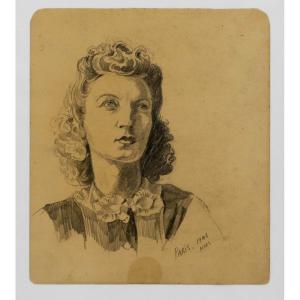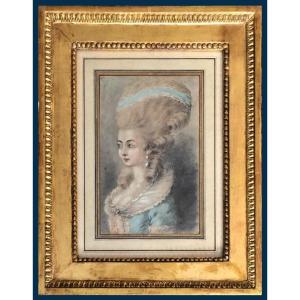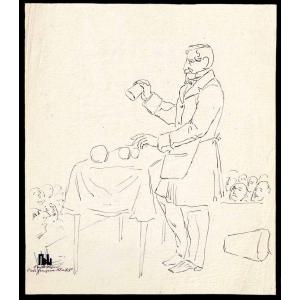- minor browning, collection stamp on the reverse
- In the shadow of betrayal -
This painting is the sketch for the head of the Pharisee offering the coins to Judas in one of Herrmann Prell's major works, the painting Betrayal of Judas, completed in 1886. The painting belongs to the Staatliche Kunstsammlungen Dresden and is illustrated in Adolf Rosenberg: Prell, Bielefeld and Leipzig 1901, p. 21 (Fig. 19). It is especially highlighted in Thieme-Becker (vol. 27, p. 376).
The monumental head, which fills the picture and is distinguished by its ornamented robe, is almost a lost profile, which in the executed painting is justified by the Pharisee's turning towards Judas. Despite the fact that the sitter withdraws from the viewer by turning away, it was necessary to artistically elaborate the motivation for the purchase of one of Christ's disciples, which is why the drawing focuses on the expression of the face, while the 'accessories' are treated in a more summary manner.
In characterising the face, Hermann Prell performs a balancing act: since the Pharisee, despite his destructive actions, is an actor in the history of salvation, the head must show a dignity appropriate to the event, but at the same time the physiognomy must also bear witness to the scheming attitude that led to the betrayal. To solve this dilemma, Prell draws on the traditional depictions of the heads of the apostles, shading the face to indicate the obdurate darkness of the spirit and moving the base of the nose slightly upwards while the mouth falls away, thus giving a physiognomic expression to the motivation of the action. The fatal drama of the betrayal is expressed in the monumentalisation of the head and in the thunderous white highlights that contrast with the darkness of the chalk.
As a study, considered by the artist to be a work in itself, this drawing reveals the pictorial problems and brainstorming of monumental painting.
About the artist
In 1872 Prell, who was one of the most important exponents of monumental painting of his time, began studying painting with Theodor Grosse at the Dresden Academy of Art and continued with Carl Gussow at the Berlin Academy in 1876. Hans von Marées taught him in Rome in 1878. More influential on his work, however, were Arnold Böcklin and Max Klinger, with whom Prell had been friends since his student days and with whom he worked together on several occasions.
Prell's first major work, which established his reputation as a monumental painter, were the frescoes in the banqueting hall of the Architektenhaus in Berlin in 1881/82, commissioned by the state and depicting the different periods of architecture. Prell then went to Italy for two years to study fresco painting. Other major commissions followed. These included monumental frescoes in the town halls of Worms (1884), Hildesheim (1882-92), Gdansk (1895) and Dresden, the staircase of the Silesian Museum of Fine Arts in Breslau (1893/94), the throne room of the German Embassy in Rome (1896-99) and the staircase of the Albertinum in Dresden (1900-1904).
From 1886 Prell taught at the academy of arts in Berlin and in 1892 he was appointed professor at the academy of arts in Dresden. His students included Osmar Schindler and Hans Unger. During his time in Dresden Prell belonged to the group around Carl Bantzer, who later formed the Goppeln artists' colony.
An extensive collection of Hermann Prell's works is kept at the Städtische Galerie Dresden. Otto Schiller and Martin Schauss made busts of Hermann Prell and Walter Witting a medal of honour. In the Roemer Museum in Hildesheim a whole room was once dedicated to Hermann Prell. Many of Prell's important works were lost in 1945.
"On the basis of studies, Prell chose an ideal style based on the forms of the High Renaissance, but aiming for a naturalistic, illusionistic effect. In the overall composition of his cycles, Prell endeavoured to ignore the wall in the Baroque sense and to give the viewer a sense of spatial expansion through fictitious openings in the wall".
Hans Vollmer in Thieme-Becker
Selection of public collections that own works by Hermann Prell:
Albertinum Dresden, Städtische Kunstsammlung Chemnitz, Stadtmuseum Bautzen.
Selected bibliography
Adolf Rosenberg: Prell. Mit 115 Abbildungen nach Gemälden, Zeichnungen und Skulpturen, Bielefeld 1901.
George Galland: Hermann Prell. Fresken, Skulpturen und Tafelbilder des Meisters, Leipzig 1916.
Hartwig Fischer: Ein Wilhelminisches Gesamtkunstwerk auf dem Kapitol. Hermann Prell und die Einrichtung des Thronsaals in der Deutschen Botschaft zu Rom 1894–1899. Hamburg 1998.
Christel Wünsch: Hermann Prell. In: Die Kunst hat nie ein Mensch allein besessen. Dreihundert Jahre Akademie der Künste und Hochschule der Künste Berlin. Katalog Akademie der Künste und Hochschule der Künste, Berlin 1996, S. 317–319.
Heike Biedermann, Katrin Bielmeier: "Aber befreit empor zum Äther kreisen die Musen". Zur Ausgestaltung des Treppenhauses im Albertinum durch Hermann Prell. In: Dresdener Kunstblätter 54,4 (2010), S. 228-232.




































 Le Magazine de PROANTIC
Le Magazine de PROANTIC TRÉSORS Magazine
TRÉSORS Magazine Rivista Artiquariato
Rivista Artiquariato